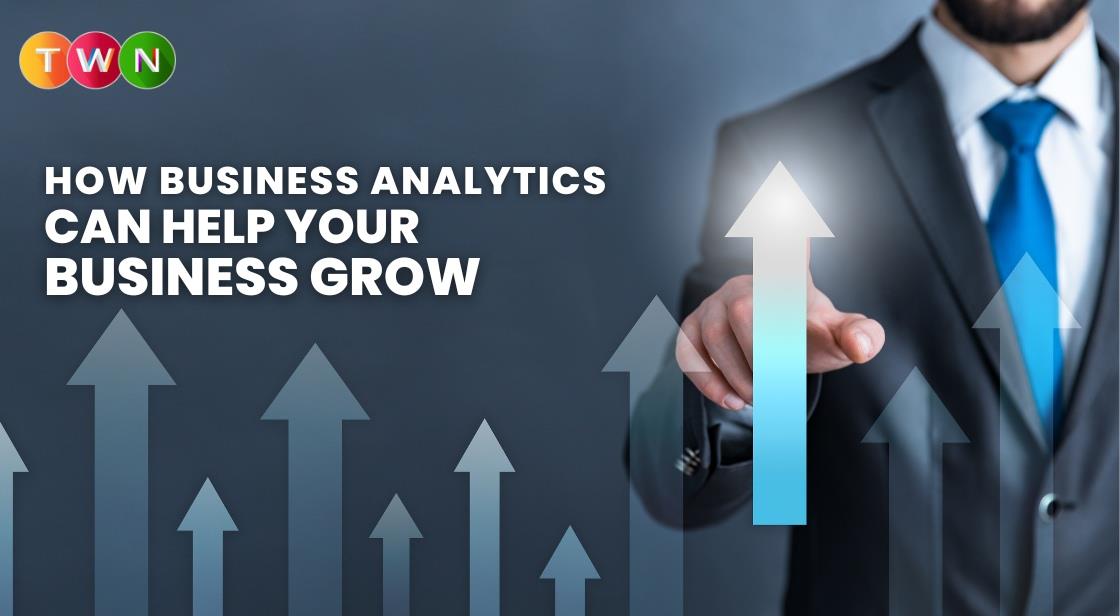How Business Analytics can Help Your Business Grow

Blog Post
In today's rapidly evolving business landscape, organizations face numerous challenges and opportunities. To thrive and gain a competitive edge, businesses must harness the power of data and insights.
This is where business analytics comes into play. By utilizing advanced analytical tools and techniques, businesses can unlock valuable insights, make data-driven decisions, and fuel growth.
Business analytics continues to evolve rapidly, driven by advancements in technology, increasing data volumes, and the need for data-driven decision-making. By embracing the latest trends and leveraging the power of descriptive, predictive, and prescriptive analytics, businesses can unlock valuable insights, drive growth, and gain a competitive edge in today's dynamic marketplace.
This article delves into the significance of business analytics and how it can help your business thrive in the dynamic marketplace.
Analytics has been widely adopted by businesses to streamline operations and improve processes. However, incorporating analytics data into intelligent and successful business decisions is not as simple as snapping one's fingers. Nearly 97 percent of respondents in a Bloomberg Businessweek Research Services study said their organizations had implemented analytics.
The opportunity to cut expenses, increase profitability, and improve risk management were the three most desired outcomes. Many businesses, on the other hand, struggle to ensure that their data is reliable and consistent.
The goal is to grasp how analytics might benefit your company and to start addressing any issues that you believe are critical to short- and long-term success.
Unleash the potential of your business with the transformative capabilities of business analytics. Learn how data-driven insights can drive growth, optimize operations, and enhance customer satisfaction.
How Business Analytics can Help Your Business Grow
I. Understanding Business Analytics:
Defining Business Analytics:
Unraveling the concept of business analytics and its key components, including descriptive, predictive, and prescriptive analytics.
In today's data-driven world, business analytics has become a crucial discipline for organizations seeking to extract valuable insights from their data. Business analytics involves the process of collecting, analyzing, and interpreting data to gain actionable insights that drive informed decision-making and improve business performance. Let's explore the key components of business analytics:
1. Descriptive Analytics:
Descriptive analytics focuses on understanding past events and extracting insights from historical data. It involves summarizing and visualizing data to identify trends, patterns, and key performance indicators (KPIs). By leveraging descriptive analytics, businesses can gain a comprehensive understanding of their current state, assess historical performance, and identify areas for improvement.
2. Predictive Analytics:
Predictive analytics utilizes statistical models and machine learning algorithms to forecast future outcomes based on historical data. It analyzes patterns and relationships within data to make predictions and estimate probabilities. With predictive analytics, businesses can anticipate trends, customer behavior, demand patterns, and potential risks. This empowers organizations to make proactive decisions, optimize resources, and identify opportunities for growth.
3. Prescriptive Analytics:
Prescriptive analytics goes beyond predicting future outcomes and provides recommendations for actions to optimize decision-making. By leveraging optimization algorithms and simulation models, prescriptive analytics helps businesses identify the best course of action to achieve desired outcomes. It considers various constraints, scenarios, and trade-offs to provide actionable insights for strategic planning, resource allocation, and process optimization.
A- Latest Trends and Updates in Business Analytics:
Advanced Analytics Techniques:
Organizations are increasingly adopting advanced analytics techniques such as machine learning, natural language processing, and artificial intelligence to extract deeper insights from their data. These techniques enable more accurate predictions, personalized recommendations, and automation of decision-making processes.
Real-time Analytics:
With the growing availability of real-time data, businesses are leveraging real-time analytics to gain immediate insights and make agile decisions. Real-time analytics enables organizations to respond quickly to changing market conditions, customer preferences, and operational requirements, enhancing their competitiveness in dynamic environments.
Data Visualization and Dashboards:
Data visualization tools and interactive dashboards have gained significant importance in business analytics. These tools enable users to explore data visually, uncover hidden patterns, and communicate insights effectively. With the rise of self-service analytics, businesses are empowering users at all levels to leverage data visualization tools for data exploration and decision support.
Embedded Analytics:
Embedding analytics capabilities directly into operational systems and applications is gaining popularity. This integration allows users to access and analyze data within their existing workflows, facilitating data-driven decision-making without the need for separate analytics platforms.
Ethical and Responsible Analytics:
With the increasing emphasis on data privacy and ethics, organizations are focusing on implementing responsible analytics practices. This includes ensuring data security, transparency in algorithms, and ethical use of customer data to build trust with stakeholders.
B. The Role of Data:
Exploring the importance of data as the foundation of business analytics and the need for data management and quality assurance.
In the realm of business analytics, data serves as the fundamental building block for generating valuable insights and making informed decisions. The quality, reliability, and accessibility of data significantly impact the effectiveness and accuracy of business analytics initiatives. Let's delve into the role of data in business analytics and the importance of data management and quality assurance:
-
Data as the Foundation of Business Analytics:
-
Data-driven Decision Making: Businesses today are increasingly relying on data to drive decision-making processes. By leveraging data, organizations can gain valuable insights into customer behavior, market trends, operational efficiency, and financial performance. These insights enable businesses to make informed decisions, mitigate risks, and identify growth opportunities.
-
Data-Enabled Innovation: Data serves as a catalyst for innovation and business transformation. With access to comprehensive and accurate data, organizations can uncover hidden patterns, discover new market segments, and develop innovative products and services. Data-driven innovation allows businesses to stay ahead of the competition and adapt to evolving customer demands.
-
-
Need for Data Management:
-
Data Integration: Organizations often have data stored across multiple systems and databases. Effective data management involves integrating data from various sources into a centralized and consistent format. This enables businesses to have a unified view of their data and facilitates meaningful analysis.
-
Data Governance: Establishing data governance practices ensures that data is properly managed, secured, and compliant with regulatory requirements. Data governance involves defining data policies, assigning responsibilities, and implementing controls to maintain data integrity and privacy.
-
Data Quality Assurance: Data quality plays a critical role in the accuracy and reliability of analytics outcomes. Data quality assurance involves validating and cleansing data to remove inconsistencies, errors, and duplicates. By ensuring data accuracy, businesses can trust the insights derived from their analytics processes.
-
-
Data Security and Privacy:
-
With the increasing concerns around data breaches and privacy, organizations must prioritize data security. Implementing robust security measures, such as encryption, access controls, and regular audits, helps protect sensitive data from unauthorized access and mitigate potential risks.
-
Compliance with Regulations: Organizations must adhere to data protection regulations, such as the General Data Protection Regulation (GDPR) and the California Consumer Privacy Act (CCPA). Compliance with these regulations ensures that customer data is handled responsibly, fostering trust and loyalty among customers.
-
Latest Trends and Updates in Data Management:
-
Big Data and Unstructured Data: The volume, variety, and velocity of data continue to increase with the advent of technologies like the Internet of Things (IoT) and social media. Businesses are leveraging big data analytics techniques to extract insights from large and diverse datasets, including unstructured data such as text, images, and videos.
-
Cloud-based Data Management: Cloud computing has revolutionized data management by providing scalable storage, processing power, and analytics capabilities. Cloud-based data management solutions offer flexibility, cost-effectiveness, and easy accessibility, empowering organizations to manage and analyze large datasets without significant infrastructure investments.
-
Data Governance and Privacy Regulations: Governments around the world are implementing stricter regulations to protect consumer data and ensure privacy. Organizations need to stay updated with the evolving regulatory landscape and establish robust data governance frameworks to maintain compliance and safeguard customer information.
-
Data Quality Automation: Automation technologies, such as artificial intelligence and machine learning, are being utilized to automate data quality assurance processes. These technologies can identify data anomalies, perform data cleansing tasks, and improve data accuracy and consistency, thereby enhancing the efficiency of data management practices.
By recognizing the pivotal role of data and implementing robust data management and quality assurance practices, businesses can maximize the value derived from their analytics initiatives.
Also Read: 5 Ways of Paying Attention to Customers Marketing Edition
II. Driving Growth Strategies:
In today's competitive business landscape, market analysis and segmentation play a crucial role in driving growth strategies. By harnessing the power of analytics, businesses can gain deep insights into market trends, customer preferences, and segmentation, leading to more effective marketing strategies and informed business expansion. Here's an overview of how analytics is utilized in market analysis and segmentation
-
Identifying Market Trends:
-
Data-driven Insights: Analytics enables businesses to analyze large volumes of data from various sources, such as customer behavior, sales records, and industry reports. By leveraging advanced analytics techniques, such as data mining and machine learning, businesses can identify hidden patterns, market shifts, and emerging trends.
-
Competitive Intelligence: Analytics helps businesses monitor and analyze their competitors' activities, pricing strategies, and market positioning. This information allows organizations to adapt their strategies, differentiate their offerings, and seize competitive advantages.
-
-
Understanding Customer Preferences:
-
Customer Segmentation: Analytics enables businesses to segment their customer base based on various criteria, such as demographics, purchasing behavior, and preferences. By creating meaningful customer segments, businesses can tailor their marketing efforts, develop personalized campaigns, and deliver relevant products or services to specific customer groups.
-
Customer Lifetime Value (CLV): Analytics helps estimate the CLV of customers, which represents the projected revenue a business can expect from a customer over their lifetime. By identifying high-value customers, businesses can allocate resources effectively, build customer loyalty, and optimize marketing strategies to maximize long-term profitability.
-
-
Effective Marketing Strategies:
-
Personalized Marketing Campaigns: Analytics allows businesses to gather insights about individual customer preferences, purchase history, and online behavior. By leveraging this data, organizations can create targeted and personalized marketing campaigns, delivering relevant messages to specific customer segments and improving customer engagement and conversion rates.
-
Marketing Channel Optimization: Analytics helps businesses evaluate the performance of various marketing channels, such as social media, email marketing, and search engine advertising. By analyzing data on customer acquisition costs, conversion rates, and customer lifetime value, organizations can optimize their marketing budget allocation and focus on channels that deliver the best return on investment.
-
Demand Forecasting:
Using predictive analytics to forecast customer demand, optimize inventory management, and streamline production processes, leading to improved resource allocation and reduced costs.
Accurate demand forecasting is crucial for businesses to optimize their operations, reduce costs, and meet customer expectations. By leveraging predictive analytics techniques, organizations can forecast customer demand, optimize inventory management, and streamline production processes. Here's how businesses are utilizing demand forecasting with the help of analytics:
-
Predictive Analytics for Demand Forecasting:
-
Historical Data Analysis: Organizations analyze historical sales data to identify patterns, seasonality, and trends in customer demand. By understanding past sales patterns, businesses can make data-driven forecasts for future demand and adjust their operations accordingly.
-
External Factors Consideration: Predictive analytics takes into account various external factors that influence demand, such as economic indicators, weather conditions, and market events. By incorporating these factors into demand forecasting models, businesses can account for their impact and improve the accuracy of predictions.
-
-
Benefits of Effective Demand Forecasting:
-
Inventory Optimization: Accurate demand forecasting helps businesses optimize their inventory levels by ensuring they have sufficient stock to meet customer demand while minimizing excess inventory and associated costs. This leads to improved cash flow, reduced storage costs, and enhanced customer satisfaction through timely order fulfillment.
-
Supply Chain Efficiency: Demand forecasting enables businesses to align their supply chain processes, such as procurement, production, and distribution, with anticipated customer demand. This optimization minimizes bottlenecks, reduces lead times, and improves overall supply chain efficiency.
-
Cost Reduction: By accurately forecasting demand, businesses can optimize their resource allocation, production schedules, and workforce planning. This leads to reduced costs associated with overproduction, underutilized resources, and unnecessary inventory holding.
-
Latest Trends and Updates in Market Analysis and Demand Forecasting:
-
Advanced Analytics Techniques: Businesses are increasingly adopting advanced analytics techniques, such as machine learning and artificial intelligence, to analyze large volumes of data and derive more accurate insights. These techniques help organizations uncover complex patterns, make precise predictions, and gain a competitive edge in the market.
-
Real-time Data Analytics: With the advancements in technology and the availability of real-time data sources, businesses can analyze up-to-date information on customer behavior, market trends, and competitor activities. Real-time analytics allows organizations to make timely decisions, adapt their strategies quickly, and seize opportunities as they arise.
-
Integration of Multiple Data Sources: Organizations are integrating data from various sources, including customer interactions, social media, point-of-sale systems, and online platforms, to gain a comprehensive view of the market. By combining data from multiple sources, businesses can gain richer insights and make more accurate forecasts.
-
Demand Sensing: Some businesses are leveraging demand sensing techniques that use real-time data, such as social media sentiment analysis and IoT sensors, to capture and analyze customer demand signals. This approach enables organizations to respond quickly to changing customer preferences and market dynamics, enhancing their agility and competitiveness.
Leveraging analytics in market analysis and demand forecasting empowers businesses to understand market trends, customer preferences, and segmentation, leading to effective marketing strategies and informed business expansion. Accurate demand forecasting enables organizations to optimize inventory management, streamline production processes, and reduce costs. By embracing the latest trends and advancements in analytics, businesses can gain a competitive advantage and drive sustainable growth.
Optimizing Operational Efficiency:
In today's competitive business landscape, organizations are continually seeking ways to optimize their operational processes to improve productivity, reduce costs, and deliver better outcomes. Analytics plays a crucial role in identifying inefficiencies, streamlining workflows, and optimizing operational processes. Here's an overview of how analytics is utilized in process optimization:
-
Identifying Inefficiencies:
-
Data Analysis: Analytics allows businesses to analyze large datasets to identify bottlenecks, redundancies, and areas of inefficiency within their operational processes. By leveraging techniques like process mining and data visualization, organizations can gain insights into the end-to-end flow of their processes and pinpoint areas for improvement.
-
Root Cause Analysis: Analytics helps organizations identify the root causes of inefficiencies by analyzing historical data and identifying patterns or trends that contribute to process delays, errors, or resource constraints. This enables businesses to target specific areas for improvement and implement targeted solutions.
-
-
Streamlining Workflows:
-
Process Mapping: Analytics aids in visualizing and mapping out the workflow of operational processes. By analyzing the sequence of tasks, dependencies, and handoffs, businesses can identify opportunities to optimize the flow, reduce redundancies, and eliminate unnecessary steps.
-
Automation and Robotics: Analytics can identify tasks or processes that can be automated using technologies like robotic process automation (RPA) or artificial intelligence (AI). Automation eliminates manual interventions, reduces errors, and improves process speed, resulting in increased efficiency and productivity.
-
-
Optimization and Continuous Improvement:
-
Simulation and Modeling: Analytics enables organizations to create process simulations and models to test different scenarios and evaluate the impact of process changes. By simulating various alternatives, businesses can make data-driven decisions, optimize process parameters, and identify the most effective configuration.
-
Continuous Monitoring and Improvement: Analytics provides real-time monitoring capabilities to track process performance, identify deviations, and take proactive measures. By continuously monitoring key performance indicators (KPIs) and using analytics-driven insights, organizations can implement iterative improvements, ensuring sustained operational efficiency.
-
Supply Chain Management:
Leveraging analytics to optimize supply chain operations, enhance logistics, and improve inventory management, ensuring timely delivery and customer satisfaction.
Efficient supply chain management is critical for organizations to meet customer expectations, reduce costs, and maintain a competitive edge. Analytics plays a vital role in optimizing supply chain operations, enhancing logistics, and improving inventory management. Here's an overview of how analytics is utilized in supply chain management:
-
Demand Forecasting and Planning:
-
Predictive Analytics: Analytics techniques, such as machine learning and statistical modeling, are used to forecast customer demand accurately. By analyzing historical data, market trends, and external factors, organizations can optimize inventory levels, production schedules, and procurement processes to meet anticipated demand.
-
Collaboration and Visibility: Analytics facilitates collaboration and visibility across the supply chain network by integrating data from various stakeholders, such as suppliers, distributors, and retailers. This enables real-time information sharing, demand synchronization, and better decision-making.
-
-
Logistics Optimization:
-
Route Optimization: Analytics helps optimize transportation routes by considering factors such as distance, traffic patterns, and delivery time windows. By using advanced algorithms, businesses can minimize transportation costs, reduce delivery lead times, and improve customer satisfaction.
-
Warehouse Management: Analytics enables organizations to optimize warehouse operations by analyzing data on inventory levels, order patterns, and warehouse layout. This helps businesses improve space utilization, reduce order fulfillment time, and enhance inventory accuracy.
-
-
Inventory Management:
-
Demand-Driven Inventory Planning: Analytics assists in aligning inventory levels with anticipated demand by considering factors such as lead times, order frequency, and demand variability. This ensures optimal inventory levels, minimizes stockouts, and avoids excess inventory holding costs.
-
Supplier Performance Analysis: Analytics allows organizations to evaluate supplier performance based on parameters such as on-time delivery, quality, and cost. By analyzing supplier data, businesses can identify bottlenecks, negotiate better terms, and foster stronger supplier relationships.
-
Latest Trends and Updates in Operational Efficiency and Supply Chain Analytics:
-
Internet of Things (IoT) and Sensor Data: The proliferation of IoT devices and sensors provides organizations with real-time data on equipment performance, product movement, and environmental conditions. By integrating IoT data with analytics, businesses can monitor operational processes, detect anomalies, and take proactive actions.
-
Artificial Intelligence (AI) and Machine Learning (ML): AI and ML technologies are being used to analyze vast amounts of data and identify patterns and insights that human analysis alone may not uncover. These technologies enable organizations to make data-driven decisions, automate processes, and optimize operational efficiency.
-
Blockchain Technology: Blockchain has the potential to revolutionize supply chain management by enhancing transparency, traceability, and trust among supply chain partners. By using blockchain-enabled systems, businesses can track and verify product movement, reduce counterfeit risks, and improve supply chain efficiency.
Enhancing Customer Experience:
a. Customer Analytics: Utilizing customer data and analytics to gain insights into customer behavior, preferences, and sentiment, enabling personalized marketing campaigns, tailored offerings, and improved customer satisfaction.
b. Sentiment Analysis: Harnessing natural language processing and sentiment analysis techniques to understand customer feedback and sentiments, facilitating proactive customer service and reputation management.
Unleashing New Opportunities:
a. Identifying Business Opportunities: Leveraging analytics to identify emerging trends, market gaps, and untapped opportunities, enabling businesses to stay ahead of the curve and explore new revenue streams.
b. Innovation and Product Development: Utilizing data insights to drive innovation, enhance product development, and create customer-centric solutions that meet evolving market demands.
Conclusion:
In the era of data-driven decision-making, business analytics has emerged as a powerful tool for businesses across industries. By harnessing the potential of analytics, organizations can unlock valuable insights, optimize operations, enhance customer experience, and identify new growth opportunities.
The key lies in leveraging advanced analytics tools, fostering a data-driven culture, and continuously adapting to the evolving business landscape. Embrace the transformative capabilities of business analytics and pave the way for sustainable growth and success in the dynamic marketplace.
You May Like
EDITOR’S CHOICE












